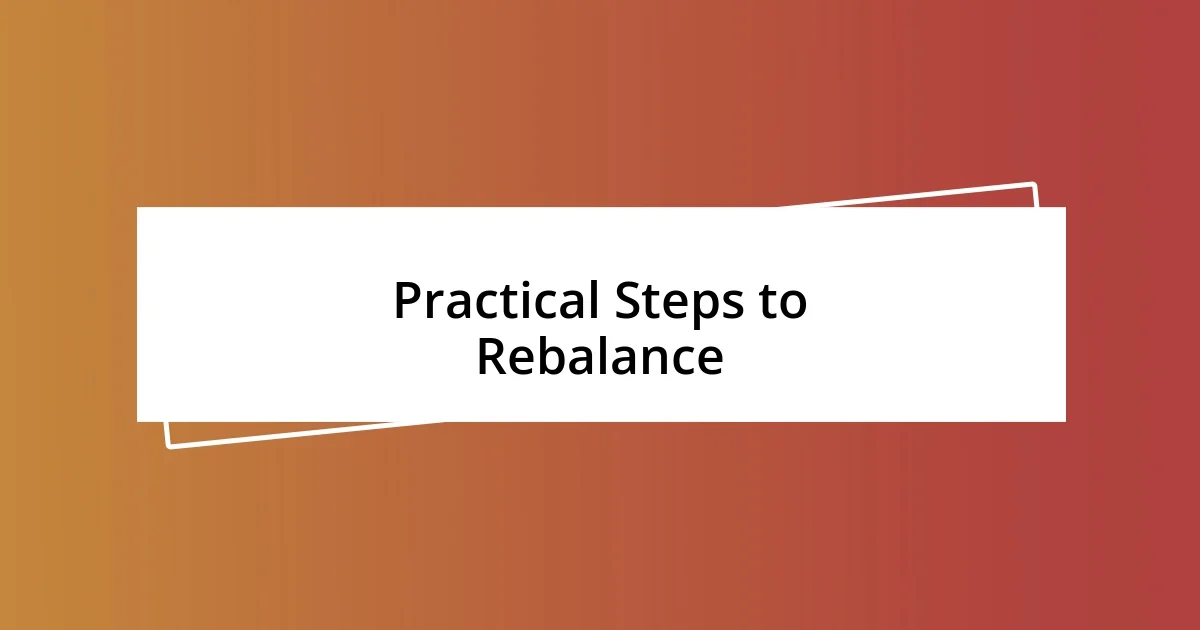Key takeaways:
- Portfolio rebalancing is essential for maintaining desired asset allocation and managing investment risk over time.
- Establishing a disciplined rebalancing strategy helps prevent emotional decision-making and aligns investments with personal financial goals.
- Regularly evaluating the outcomes of rebalancing allows for better alignment of asset allocation with risk tolerance and financial circumstances.

Understanding Portfolio Rebalancing
Portfolio rebalancing is like giving your investment strategy a check-up. Over time, certain assets may grow faster than others, skewing your original allocation. I recall a time when I noticed my stock holdings had ballooned after a market upswing. It felt exhilarating, but I also realized the increased risk—I had to make a decision.
The process involves adjusting your portfolio back to your desired asset allocation. This doesn’t always mean selling high and buying low, which can feel counterintuitive, right? I remember questioning whether it was wise to sell off some of my winners. In the end, I understood that rebalancing isn’t about timing the market; it’s about maintaining your investment strategy over time.
When I think about rebalancing, I also consider the emotional rollercoaster that investing can be. Are you holding onto assets because of fear or greed? I found that having a plan for rebalancing helped me stay grounded, making those decisions less daunting. Trust me, a disciplined approach takes some of the guesswork out of the equation, allowing you to focus on your long-term goals.

Reasons to Rebalance My Portfolio
Rebalancing my portfolio is crucial because it keeps my investment risk in check. I remember the time a few years ago when tech stocks surged, and my portfolio became heavily weighted in that sector. It was tempting to ride the wave, but I learned that not acting could expose me to greater volatility. Keeping a balanced approach allowed me to weather downturns without losing my bearings.
Here are several reasons why I prioritize rebalancing:
- Maintain Target Allocation: Ensures my investments align with my risk tolerance and financial goals.
- Mitigate Risk: Protects my portfolio from being overly concentrated in any single investment or sector.
- Enhance Returns: Adjusting my holdings can lead to better long-term performance by realizing gains on overperforming assets.
- Encourage Discipline: Having a scheduled review and adjustment process keeps my emotions in check, preventing impulsive decisions driven by market fluctuations.

How to Determine Asset Allocation
How to determine your asset allocation isn’t just about numbers; it’s a reflection of your personal financial goals, risk tolerance, and investment timeline. I always start by asking myself, “What am I investing for?” For instance, if I’m targeting retirement in 25 years, my strategy might lean toward stocks for growth. But if I’m looking at a goal within five years—like buying a house—I’d focus more on bonds or cash equivalents to be sure my money is safe and available.
Next, I take a good hard look at my risk tolerance. Understanding how much volatility I can handle helps shape my asset mix. I remember when the market took a nosedive; my heart raced even as I knew my investments were long-term. That emotional response taught me to find a balance that keeps me comfortable. Consider asking yourself: “How would I react if my portfolio dropped by 20%?” Your answer can guide your decisions significantly.
Lastly, periodically reviewing and adjusting your allocations is vital. I’ve made it a habit to reassess my portfolio annually. Each time, I often find something unexpected. For example, I discovered how a few underperforming assets lingered too long simply because I didn’t want to part with them. My goal is to keep my investments aligned with where I see my future—both financially and emotionally.
| Investment Horizon | Suggested Asset Allocation |
|---|---|
| Short-Term (0-5 years) | More conservative with bonds and cash equivalents (60-80% bonds) |
| Medium-Term (5-10 years) | Balanced mix of stocks and bonds (50% stocks, 50% bonds) |
| Long-Term (10+ years) | Growth-oriented with higher stocks allocation (70-90% stocks) |

Practical Steps to Rebalance
When it’s time to rebalance my portfolio, I start by reviewing each investment’s performance against my target allocation. Recently, I noticed that my real estate investments had outperformed the rest of my portfolio, so I nudged those gains back toward my original goals. It’s like tidying up my room—I aim for a welcoming balance rather than letting things pile up.
Next, I take a close look at any potential tax implications of rebalancing. I remember feeling a bit anxious when selling a few gains; the thought of taxes loomed over me. However, I realized that maintaining the right balance would alleviate future stress, as it’s critical to keep my portfolio aligned with my long-term plans. Does paying a little now outweigh the risk of a bigger problem down the line? In my experience, it often does.
Once I’ve made adjustments, I find it essential to set a calendar reminder for my next review, maybe six months down the line. This helps me avoid the trap of letting emotions dictate my investment strategy. The last time I did this, I felt surprisingly empowered, knowing I had a plan in place. It becomes a habit, just like going for a regular check-up; taking action today can keep me healthy for years to come.

Timing Your Rebalancing Strategy
Timing your rebalancing strategy is a crucial aspect that I’ve learned to navigate carefully over the years. I’ve found that setting specific intervals for reviews—such as quarterly or semi-annually—helps me avoid relying solely on market fluctuations. For example, after a particularly volatile quarter a few years back, I realized I could have missed opportunities by not sticking to my review schedule. It taught me that the market’s ups and downs shouldn’t dictate my commitment to my plans.
When I consider the market’s performance and my investment goals, I often ask myself, “Is now the right time, or should I wait?” It’s a tricky balance. I remember the panic during the market downturn in early 2020; following my instinct to rebalance even when it felt uncomfortable ultimately allowed me to ride the recovery. I learned that being proactive rather than reactive can lead to better long-term outcomes.
Interestingly, I’ve discovered that combining both a schedule and a rule-based approach—like rebalancing when my asset allocation drifts more than 5%—works wonders. This method helps me take the emotion out of the equation. I recall when a sudden surge in tech stocks made my portfolio look much heavier in that sector. Instead of letting excitement lead my decision-making, sticking to my defined rules kept me grounded and aligned with my overall strategy. Wouldn’t you agree that having such a system in place allows for more confidence in our choices?

Common Mistakes in Rebalancing
Rebalancing can be a double-edged sword, and one of the common mistakes I’ve witnessed is overlooking fees associated with buying and selling assets. The first time I restructured my portfolio, I was so fixated on achieving my ideal allocation that I neglected to consider how much I was spending on transaction fees. It was a rude awakening when I realized those costs ate into my gains. Have you ever thought about how seemingly small fees can accumulate over time? Trust me, they can add up and undermine your hard work.
Another pitfall is rebalancing too frequently. I recall an instance where I was tempted to adjust my portfolio every time a market news headline caught my eye. It felt like I was spring cleaning my investments constantly, but it became exhausting. Each adjustment, while well-intentioned, only introduced more volatility than necessary. Balancing out your portfolio is important, but so is allowing time for your investments to settle. Is it really worth it to react to every market fluctuation, or should we give our strategies some breathing room?
Finally, a mistake I often see—and have made myself—relates to emotional decision-making. I remember feeling the urge to sell off stocks during a downturn out of sheer fear, convinced that I could cut my losses. Yet, reflecting on those moments, I realized that making decisions based solely on emotions can lead to regret down the line. Wouldn’t it be wiser to stay committed to a strategy aligned with my long-term goals? Having a solid plan is key, and learning from those emotional missteps has made me a more resilient investor.

Evaluating Results After Rebalancing
Evaluating the results after rebalancing is where the real learning occurs for me. Each time I adjust my portfolio, I take a moment to reflect on how those changes align with my long-term goals. For instance, during my last rebalance, I noticed that the sectors I had trimmed were performing well, and it made me rethink my strategy about sticking only to performance metrics. Was clinging to my original allocations potentially limiting my growth? It’s a balance between following my rules and being open to opportunity.
I also find that comparing my results post-rebalance to market indices gives me a clearer picture of how effective my strategy has been. There was a period when I had completely outperformed the market after rebalancing—just watching my portfolio thrive filled me with a sense of accomplishment. But here’s the kicker: I realized that pure luck could have played a role too. Should I celebrate my decisions, or should I focus on making them consistently? It’s this kind of questioning that keeps me grounded.
After each reevaluation, I inevitably consider if my asset allocation still reflects my risk tolerance and financial situation. There have been times when I risked too much, leading to anxiety and sleepless nights. I learned that rebalancing isn’t just about numbers; it’s about emotional peace. How can we optimize our portfolios without sacrificing our sense of security? Balancing returns with peace of mind is not just smart—it’s essential.














